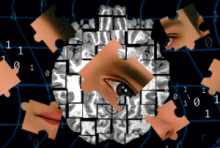- A groundbreaking new technique has been developed to digitally reconstruct images of what people see based on their brain activity
- By interpolating neural data in comparison with a known visual source, the research team has developed a way to extract, assess, and visualize information from electroencephalography (EEG) readings
- This first-of-its-kind technique has been proven on face processing using a known visual source, and the next phases of development will explore image reconstruction based on memories and dreams
- Developed at U of T Scarborough by Assistant Professor Adrian Nestor and postdoctoral fellow Dan Nemrodov in the Visual Recognition Lab [VisRecLab]
- Recreating images from fMRI activity is an established field of research, however using EEG data for image reconstruction has great practical appeal for consumer applications because it is less expensive and more portable than fMRI
- The technology has the potential to unlock exciting applications in:
- Marketing: Attention; ad recall; purchase intention; buyer behaviour
- Brain-Computer Interface: Allow users to control computers without physically interacting with an input device.
- Communication: A consumer product that allows people to see the world through one another’s eyes; memory augmentation
- Healthcare: Social interaction with people who can’t communicate verbally or with sign language, including ‘gray zone’ vegetative patients or those with locked-in syndrome (LIS); an Autism diagnostic tool
- Legal: Witness identification; forensics for eyewitness testimony
IP:
- Patent granted in US and Canada: US10925509B2 System and method for generating visual identity and category reconstruction from electroencephalography (EEG) signals
- Available for licensing
Donna Shukaris
Innovations & Entrepreneurship Manager
Innovations & Partnerships Office (IPO)
(416) 946-7247





